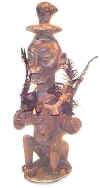 |
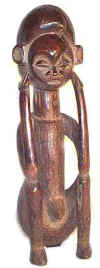 |
|||
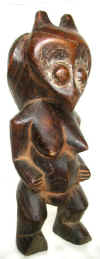 |
||||
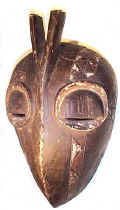 |
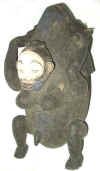 |
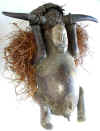 |
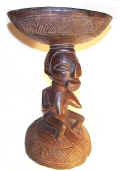 |
|
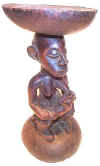 |
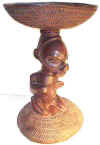 |
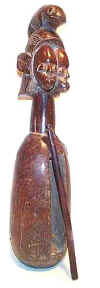 |
 |
|
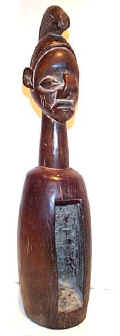 |
 |
 |
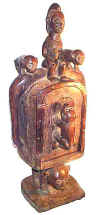 |
TRIBAL AFRICAN ART
YAKA (BAYAKA)
Democratic Republic of the Congo
The Kwango River area (southwest of the Democratic Republic of the
Congo) is the home of some 300,000 highly artistic Yaka people. Yaka or yakala
means “males,” “the strong ones,” thus Bayaka, “the strong
people.” The
Yaka society is organized into strong lineage group headed by elders and lineage headmen. The
chief of the lineage had the power of
life
and death over lineage members. He was in charge of the
cult of the ancestors and judiciary authority, and it was compulsory that he have large
number of descendants. Chiefs, including dependent village chiefs, regional
overlords, and paramount chiefs, are believed to have extra-human abilities, ruling the
underworld or spiritual realm as well as the ordinary world. A chief participates in the
affairs of witches so that he can tap their power for the good of the community. On
the periphery of the hierarchy, the “master of the earth” plays an important
role during the rites that accompany the hunt – the primary activity of the men. The
Yaka hunters perform a specific ritual under the direction of the “master of the
earth” to guarantee that they procure game. The Yaka have an initiation, the n-khanda.
A special hut is built in the forest to give shelter to the postulants during their
retreat; the event ends in circumcision, an occasion for great masked festivities
including dances and songs.
The n-khanda is organized every time there are enough eligible youths between ten
and fifteen years of age.
The arts of the Yaka people are very much alive today.
The statues that contain magic ingredients, the biteki (nkisi), are
multi-functional and sometimes have contradictory roles, for example, they were used to
heal and to cause illness. The medications are placed in the figure’s abdomen, which
is closed up with a resin stopper, or enclosed in small bags hung around the neck or waist.
All nkisi figures are manipulated by a diviner to activate a force which
can either inflict illness or protect one’s clan from illness or harm, depending upon
the particular set of circumstances. The diviner has an important position in Yaka society
because he owns and activates powerful objects, including some masks, that can protect or
harm.
The
Yaka also have statues of chiefs which are not, however, portraits. These emphasize his
authority by representing the chief, his many wives, his children, and his servants,
gather together in the same shelter. Large, life-size carved figures stand at the
entrances of Yaka initiation huts, the inside walls of which are covered with painted bark
panels. The
torso is highly developed; missing extremities allude to an accident that befell a hero. The phuungu, a statuette of some 6”
belongs to the chief of the patrilinear lineage. The torso is wrapped in magic ingredients
and has an almost spherical shape; often hooked onto the roof of the hut, it receives
libations of blood that activate its power.
The masks
are commonly used. The eastern Yaka mask is called kakunga (“the
chief”) and is considered one of the important masks in the circumcision ceremony.
Other Yaka masks are widely varied in style, although most of them are polychrome. The nkisi
masks have a long, exaggerated upward-hooked nose, open mouth. Many masks and figures are
remarkable by the turned-up nose. This is a strange but common detail, and there
is no decisive explanation for this nose. One source supposes that it is an
allusion to the elephant's trunk. A long handle under the chin was held by the dancer. The
mask is generally surmounted by a richly ornamented, abstract construction –
sometimes resembling a Thailand pagoda; sometimes in animal shapes, made of twigs, covered
with fiber cloth, and finally painted. A
variant is the broad-nosed polychrome mask, with round, protruding eyes and square,
block-like ears. These two types of masks were used in initiation ceremonies of the mukanda
or nkanda societies. At the conclusion of the initiation, the masks were held in
front of the faces of the dancers. There are also animal masks. The masks
fulfill several functions: some serve as protection against evil forces, others ensure the
fertility of the young initiate. Their role consists in frightening the public, healing
the sick, and casting spells. The kholuka mask dances alone at the end of
celebrations. Very popular, featuring globular or tubular eyes, a protuberant or snub
nose, and an open mouth showing its teeth, it sometimes has a hairdo of branches covered
with raffia. All refer to the power of the elders and their predecessors, and every
element of the mask is the plastic translation of a cosmological term. The colors are
those of the rites of passage; the serpent motif symbolizes the rainbow and the moon. After undergoing various trials in more or
less secret camps, the initiates appear in the village, dancing and wearing masks prepared
for this purpose.
The Yaka use a narrow
cylindrical wooden slit-drum with a carved head for divination purposes. Sometimes the
head is Janus form. This instrument, the main insignia of the diviner, is the focus of a
complex system of ritual institutions concerned with hereditary curses and curing. The
slit-drum functions in a variety of contexts. It
is used as a container for preparing and serving divinatory medicines, but it is also
beaten at the funeral of a diviner.
The Yaka give an aesthetic touch to many everyday objects such as stools, combs, pipes, headrests, and musical instruments.